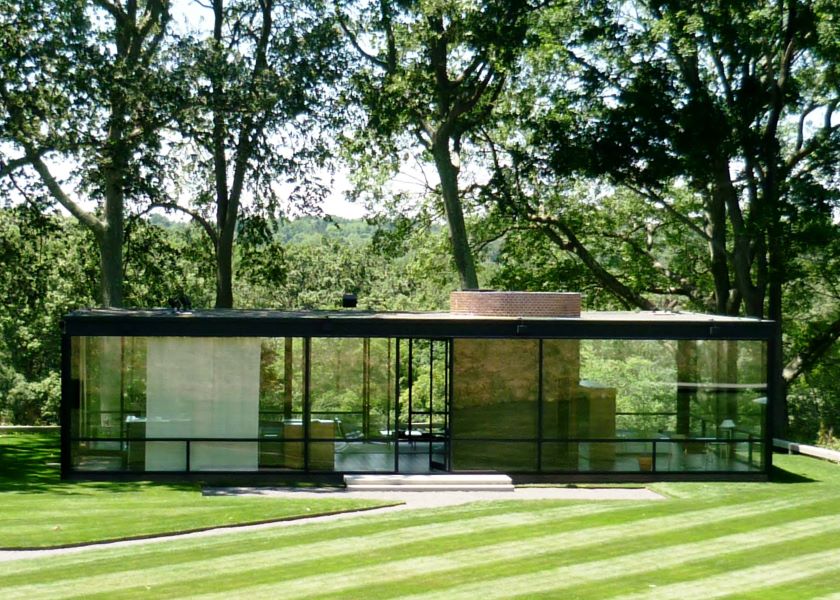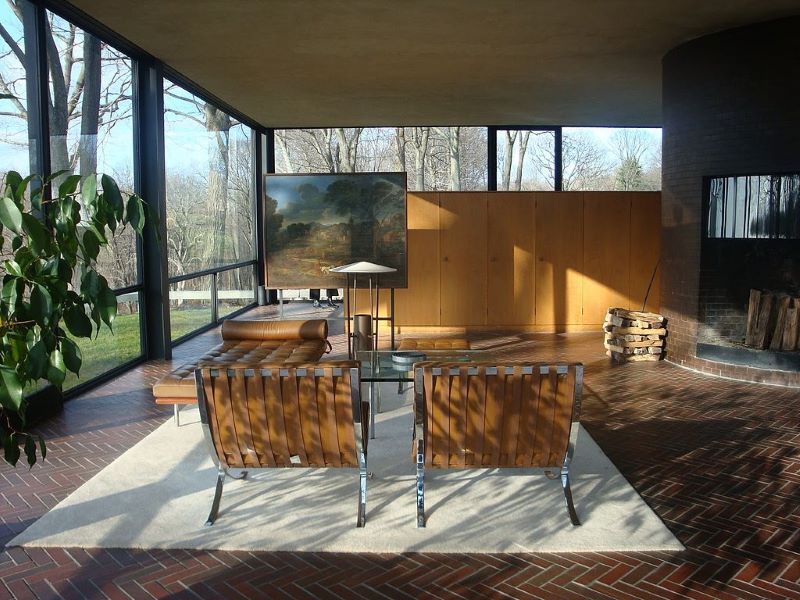They say people in glass houses shouldn’t throw stones. But has anyone every literally lived in a glass house?
Turns out, someone has. Tucked into the quiet, undulating hills of New Canaan, Connecticut, the Philip Johnson Glass House is one of the most iconic and unconventional architectural landmarks in the United States. Designed in 1949 by renowned architect Philip Johnson as his personal residence, the house is a masterwork of modernist design, celebrated for its minimalist aesthetic and nearly invisible profile against the natural landscape. Composed almost entirely of glass and steel, the 1,815-square-foot structure eliminates traditional barriers between inside and out, inviting the surrounding meadow and forest into its living space and creating harmony between architecture and environment.

Philip Johnson Glass House by Mark B. Schlemmer licensed underCC BY 2.0
Philip Johnson drew inspiration from Ludwig Mies van der Rohe’s Farnsworth House in Illinois, embracing the International Style’s guiding principles of simplicity, functionality, and transparency. The Glass House was Johnson’s first building on the 49-acre property, and it marked the beginning of an ambitious creative experiment.
Over the following decades, Johnson continued to develop the estate into a complex of over a dozen structures that each explored different architectural ideas and artistic concepts. These include the stark, concrete-and-brick “Studio,” the rustic-yet-geometric “Pavilion in the Pond,” and the enigmatic “Ghost House,” a red-and-black open frame structure nestled among trees that reads like an architectural shadow or a mirage.
Perhaps most surprisingly, the Glass House is also home to extensive underground art galleries that were not open to the public until after Johnson’s death in 2005. These galleries include rotating exhibitions as well as permanent works by artists such as Andy Warhol, Frank Stella, and Julian Schnabel, creating an immersive experience in which contemporary art converges with nature and design. The landscape itself is curated as meticulously as the architecture, with sight lines, walkways, and carefully framed views that reflect Johnson’s belief that the environment is as integral to the building as the walls — or in this case, the lack of them.
You Might Also Enjoy: Offbeat Travel: The Whispering Gallery in Grand Central Station

Glass House Interior by Edelteil licensed under CC BY-SA 3.0
Located just over an hour by train from New York City, the Glass House is accessible via the Metro-North Railroad, with a short shuttle or taxi ride from the New Canaan station. This accessibility makes it an ideal offbeat day trip for design enthusiasts, art lovers, or curious travelers eager to escape the city’s bustle and step into a place where architecture becomes meditation. Visits are available exclusively through guided tours, which must be booked in advance through the National Trust for Historic Preservation.
The visitor experience begins at the Glass House Visitor Center in downtown New Canaan, where guests are shuttled to the estate and guided through an intimately curated tour of the grounds and buildings. Guests can choose from a range of tours, from one-hour intros to immersive two-and-a-half-hour explorations of the full site. As guests walk the grounds, they trace the evolution of Johnson’s architectural philosophy — his meticulous exploration of form, proportion, and transparency—and see firsthand how his legacy has influenced generations of designers worldwide.
The Philip Johnson Glass House is a fully realized vision that challenges the way we inhabit and perceive space. Off the beaten path and delightfully unconventional, it offers an unforgettable encounter with architecture that refuses to be boxed in.
Have you ever visited the Glass House? Tell us about it in the comments below!
Featured Image: Philip Johnson Glass House by Mark B. Schlemmer licensed under CC BY 2.0




Leave a Reply